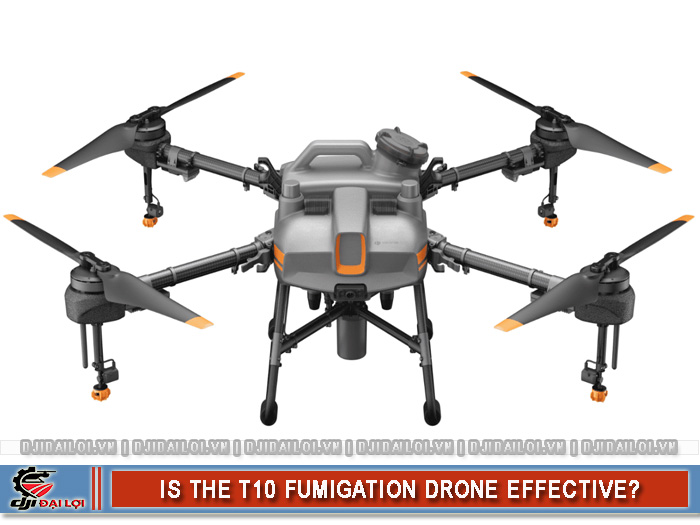
The DJI Agras T10 is an agricultural drone designed for small to medium-scale farms. It features a 10-liter tank, high-pressure spraying system, and dual radar sensors for obstacle avoidance, enabling uniform spraying across different terrains.
Its standout features include precise altitude sensors and fine mist atomization technology, which enhance droplet adhesion and reduce chemical waste. The T10’s foldable, lightweight frame makes it easy to transport and ideal for farmers adopting 4.0 agricultural automation.
Weighing only 13 kg (excluding battery), the T10 is easy to handle in narrow fields. Its dual nozzles with high-pressure pumps achieve a spray width of 5–6 meters.
Powered by a 9,500 mAh intelligent battery, it can cover 6–8 hectares per day. Compared to larger drones like the T20P or T30, the T10 consumes 30–40% less energy, reducing operating costs and making it a perfect fit for smallholders.
The T10 contributes to Vietnam’s precision agriculture transformation, minimizing farmers’ exposure to chemicals and saving 70% of water and 30% of pesticides.
Its adoption accelerates the automation of Vietnamese farming and aligns local practices with global UAV-based agricultural trends.
Trials in the Mekong Delta show the T10 can spray 2.5–3 hectares per hour at a flight speed of 6–7 m/s. Automated mapping enables coverage accuracy within ±2 cm, ensuring no area is left untreated.
Its symmetrical propeller system and precise wind control maintain excellent stability even under Level 4–5 winds.
The centrifugal atomization system produces droplets sized 80–100 microns, ensuring even coverage and reduced drift. Compared with manual spraying, the T10 cuts pesticide use by 25–30%, while minimizing environmental impact.
The terrain-following radar automatically adjusts flight height over uneven fields, enhancing spray precision.
A single T10 operator can replace 15–20 manual workers. Spraying costs drop by 40–50%, and tasks that once took days can now be completed within 2–3 hours for the same field area.
|
Criteria |
T10 |
T20P |
|---|---|---|
|
Tank capacity |
10 L |
20 L |
|
Spray output |
2.5–3 ha/hour |
4–5 ha/hour |
|
Battery consumption |
Low |
High |
|
Maneuverability |
High |
Medium |
|
Wind resistance |
Excellent |
Good |
→ The T10 suits small farms, while the T20P is better for cooperatives or large-scale operations.
The T30 features a 30L tank and a spray width of 9–10 meters - roughly double the T10’s range - but requires more takeoff space and higher battery consumption. The T10 remains easier to operate and transport, especially in fragmented fields.
Its key strengths include agility, cost efficiency, and ease of maintenance. The small tank, however, limits its use for farms above 20 hectares. For households or small cooperatives, the T10 is the most affordable and practical solution today.
Surveys in Hậu Giang and An Giang found that 85% of users reported a 10–15% yield increase compared to manual spraying. Shorter spraying times and improved pest control were also consistently noted.
The T10 battery lasts 600–700 charge cycles, while propellers and nozzles are easy to replace. With readily available DJI spare parts, maintenance is simple. Even after 2–3 seasons, the drone maintains over 95% of its original performance.
Most users confirm that the T10 provides uniform pest control, reduces chemical exposure, and significantly cuts labor expenses.
Performance may slightly decrease under strong winds (above Level 5) or low humidity (<50%). Terraced or uneven fields require manual adjustment of flight altitude to avoid overlapping spray zones.
Incorrect dilution ratios can lower adhesion and reduce effectiveness. The ideal ratio is 1:200–1:300, ensuring stable spraying and preventing nozzle clogging.
Calibrating the radar before flight ensures accurate altitude measurement. Operators should be trained in map-based route setup and auto-height adjustment to maximize coverage efficiency.
For rice, maintain a flight altitude of 2.5–3 meters; for fruit trees, over 4 meters. A flight speed of 5–6 m/s is optimal for balanced spray coverage and reduced backdraft.
After every 10 flights, clean nozzles and sensors to prevent blockage. When storing, charge batteries to 80% and avoid full discharge to extend lifespan.
Integrating DJI Terra or other smart mapping tools enables the T10 to identify specific treatment areas and prevent overlaps - saving up to 15% in chemical use.
Yes. With low investment cost, easy maintenance, and clear chemical savings, the DJI T10 is an excellent choice for small-scale farmers.
For areas under 20 hectares, the T10 is ideal. For 30 hectares or more, the T20P or T30 deliver better efficiency. Using multiple T10 units simultaneously is also a cost-effective approach.
The T10 symbolizes Vietnam’s ongoing shift toward Agriculture 4.0. As the government promotes digital transformation, this model remains a leading choice for precision farming and sustainable productivity.
Real-world data confirms that the DJI T10 offers an unmatched balance of spraying performance, durability, and affordability - securing its position as a top-tier mid-range agricultural drone.
It’s suitable for rice, corn, coffee, pepper, and fruit trees. Its radar sensors adjust flight altitude to match crop canopy height.
Yes. Farmers should register the drone with local authorities to ensure safe flight operations and compliance with UAV regulations.
Each battery provides 15–18 minutes of flight time, covering about 2 hectares per charge. Lifespan ranges from 600–700 cycles with proper care.
Yes, it is rated IP67 waterproof, but flying in heavy rain or strong winds is not recommended to maintain accuracy and safety.
Purchase only from authorized DJI distributors or official dealers in Vietnam to receive genuine products, warranty support, and operator training.